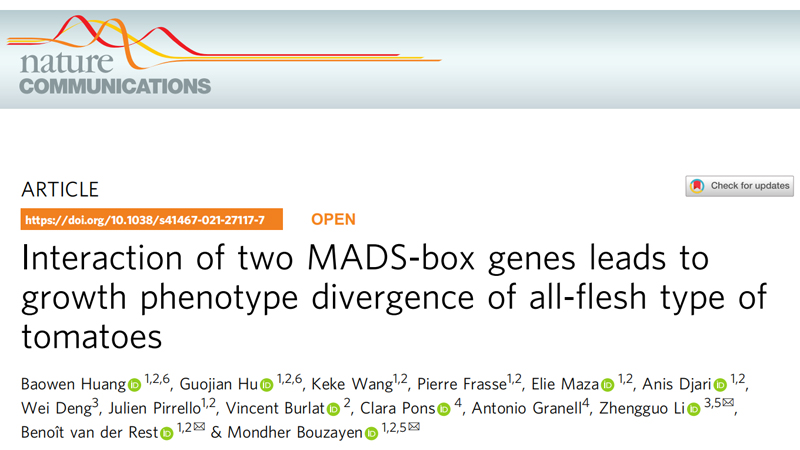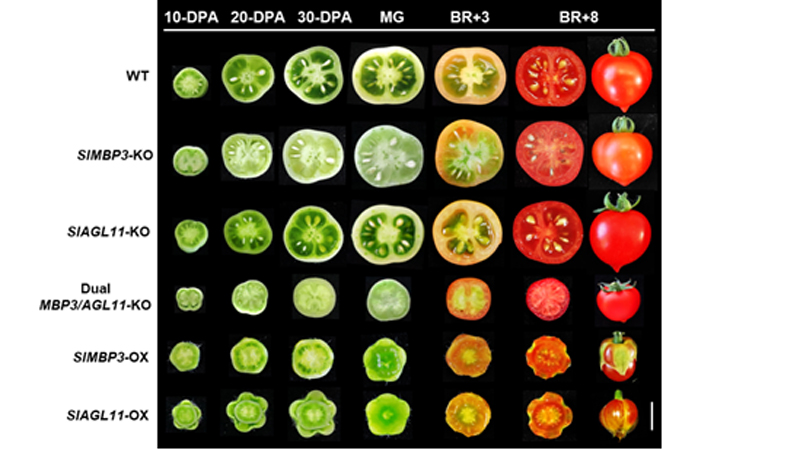The research team led by Professor Li Zhengguo and Professor Mondher Bouzayen of the Research Center for Plant Functional Genomics of Institute of Advanced Interdisciplinary Studies, Chongqing University discovered that the interaction of two MADS-box genes leads to growth phenotype divergence of all-flesh type of tomatoes in collaboration with the Plant Institute of French National Center for Scientific Research (CNRS) and Universitat Politècnica de València the other day. Based on the discovery, the team proposed the optimal breeding strategy. The discovery was published in Nature Communications under the title “Interaction of two MADS-box genes leads to growth phenotype divergence of all-flesh type of tomatoes” on November 25, 2021.

MADS box gene is a super family of transcription factors, and plays a very important role in regulating plant reproduction, growth and development. Tomato is not only an important cash crop all over the world (the annual total output value is as much as 100 billion dollars), but also a classic model plant for studying berry crops. Plants have evolved into a variety of internal morphological structures in order to adapt to their living environment. The all-flesh type of tomato is characterized by the absence of colloid and mildew resistance, and is therefore extensively favored by European and American processing enterprises and consumers. However, the regulation mechanism of tomato fruit colloid formation is still unclear by now.
Tomato with “much colloid”

“All-flesh” type of tomato

Based on the findings of previous related research, researchers found that 405 bp deletion mutation occurred in the promoter of MADS-box gene SlMBP3 of six all-flesh tomato varieties through DNA sequencing. At the same time, the research team further confirmed that SlMBP3 was a key factor affecting tomato colloid formation by regulating cell proliferation and expansion through gene recovery, CRISPR/cas9 knockout, RNA seq and ChIP-seq experiments. It was found that knockout strain that had gone through SlMBP3 exhibited high fruit hardness 10 days after full flowering (10-DAP), which lasted till ripening of the tomato. On the contrary, the fruit of SlMBP3 over-expression strain softened seriously and entered the liquefied state after the green ripe stage. In addition, SlMBP3-KO fruit also had the characteristics such as long shelf life and high content of sugar and dry matter. DNA sequencing analysis further revealed that the homologous gene SlAGL11 of SlMBP3 also had genes Natural mutation with complete deletion of locus. Therefore, the research team used CRISPR/cas9 to carry out double knockout of the two homologous genes SlMBP3 and SlAGL11. The results showed that the double knockout strains had plant dwarfing, fruit shrinking and seed deformity, which greatly limited their commercial application potential.

Researchers also found that the two MADS-box genes SlMBP3 and SlAGL11 had natural mutations. In order to obtain all-flesh type of tomato in tomato breeding, it must be considered whether the SlAGL11 gene exists to avoid the adverse effects caused by double mutation. Besides, most previous studies on the regulation of tomato fruit hardness focused on the late stage of fruit ripening and development. The results showed that the quality and hardness of fruit could be regulated in the early stage of development, which provides a new approach for fruit quality improvement and production application.
Huang Baowen and Hu Guojian from the Plant Institute of French National Center for Scientific Research (CNRS) are first co-authors of the paper. Li Zhengguo, Mondher Bouzayen and Associate Professor Benoît van der Rest from the Plant Institute of French National Center for Scientific Research (CNRS) are corresponding co-authors of the paper.
Link of the paper: https://www.nature.com/articles/s41467-021-27117-7
